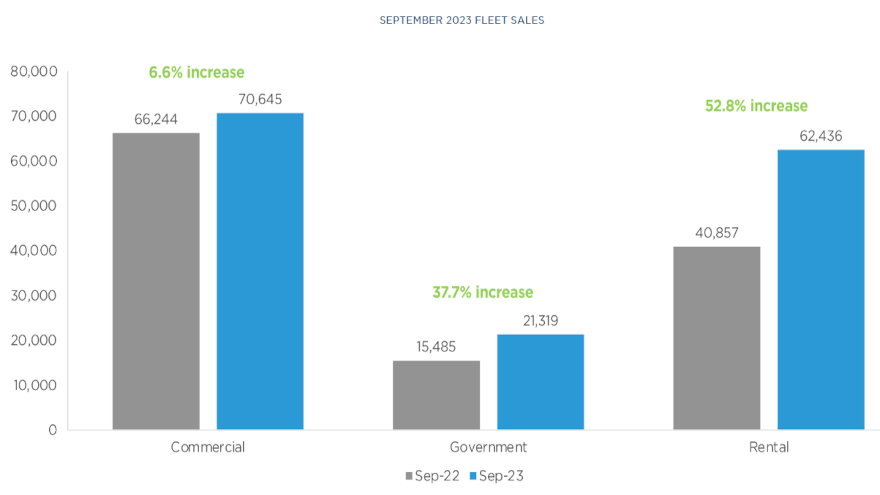Fleet sales soar 26% higher in September

Chart courtesy of Cox Automotive.
The volume of vehicles coming down the fleet or off-rental lanes at your auction of choice might be picking up in a few months.
Cox Automotive posted an analysis of Bobit data that highlighted September sales into large rental, commercial and government fleets increased notably year-over-year.
Analysts discovered sales to large fleets — excluding dealer and manufacturer fleets — jumped 26.0% with 154,400 units sold.
And during the closing month of the third quarter, Cox Automotive indicated sales to rental fleets rose 52.8%, while sales to government fleets increased 37.7%, and sales to commercial fleets ticked 6.6% higher.
“The success of the new-vehicle market this year and the increase in our full-year forecast is mainly due to the return of fleet sales.” Cox Automotive senior economist Charlie Chesbrough said in a Data Point that recapped the information.
During the same month the United Auto Workers strike began against them, Cox Automotive pointed out General Motors generated the largest increase in sales into fleet of large-volume automakers in September, while Ford posted the largest decrease.
Those trends have now happened two months in a row.
Including an estimate for fleet deliveries into dealer and manufacturer channels in September, Cox Automotive reported the remaining retail sales were estimated to be up 17.7%, leading to a retail seasonally adjusted annual rate (SAAR) of 12.9 million, up 1.1 million from last year’s 11.8 million pace and down 0.3 million from the previous month’s 12.6 million pace.
The fleet market share was estimated to be 13.8% in September, a gain of 0.6% over last year’s share but a 1.8% decrease from August’s 15.6% market share, according to the Cox Automotive analysis.
Overall, through the end of Q3, Cox Automotive determined sales into fleet channels are up 38.8% year to date.
Experts said the improvement is impacted by significant year-to-date increases in rental and government fleet sales, which are up 71.7% and 43.6%, respectively.
“Pent-up rental and commercial demand, rather than consumer demand, is particularly key to the new-vehicle market’s success,” Chesbrough said. “In the early stages of the post-COVID market, manufacturers prioritized keeping products available for dealerships, leading to fewer new vehicles sold for rental and commercial purposes. However, as vehicle production began to recover last year, fleet sales have continued to rise.”

 View The Latest Edition
View The Latest Edition

